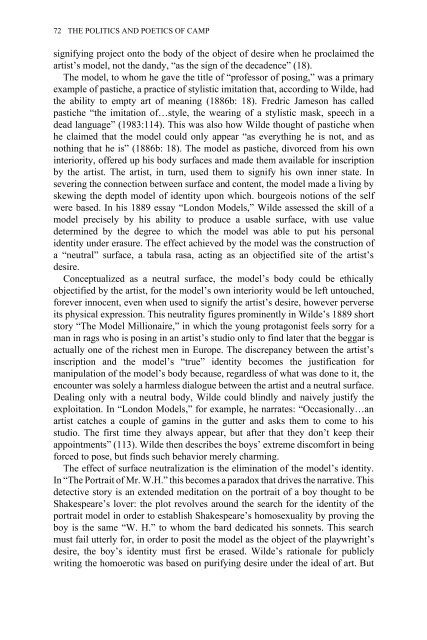Edited by Moe Meyer - Get a Free Blog
Edited by Moe Meyer - Get a Free Blog
Edited by Moe Meyer - Get a Free Blog
Create successful ePaper yourself
Turn your PDF publications into a flip-book with our unique Google optimized e-Paper software.
72 THE POLITICS AND POETICS OF CAMP<br />
signifying project onto the body of the object of desire when he proclaimed the<br />
artist’s model, not the dandy, “as the sign of the decadence” (18).<br />
The model, to whom he gave the title of “professor of posing,” was a primary<br />
example of pastiche, a practice of stylistic imitation that, according to Wilde, had<br />
the ability to empty art of meaning (1886b: 18). Fredric Jameson has called<br />
pastiche “the imitation of…style, the wearing of a stylistic mask, speech in a<br />
dead language” (1983:114). This was also how Wilde thought of pastiche when<br />
he claimed that the model could only appear “as everything he is not, and as<br />
nothing that he is” (1886b: 18). The model as pastiche, divorced from his own<br />
interiority, offered up his body surfaces and made them available for inscription<br />
<strong>by</strong> the artist. The artist, in turn, used them to signify his own inner state. In<br />
severing the connection between surface and content, the model made a living <strong>by</strong><br />
skewing the depth model of identity upon which. bourgeois notions of the self<br />
were based. In his 1889 essay “London Models,” Wilde assessed the skill of a<br />
model precisely <strong>by</strong> his ability to produce a usable surface, with use value<br />
determined <strong>by</strong> the degree to which the model was able to put his personal<br />
identity under erasure. The effect achieved <strong>by</strong> the model was the construction of<br />
a “neutral” surface, a tabula rasa, acting as an objectified site of the artist’s<br />
desire.<br />
Conceptualized as a neutral surface, the model’s body could be ethically<br />
objectified <strong>by</strong> the artist, for the model’s own interiority would be left untouched,<br />
forever innocent, even when used to signify the artist’s desire, however perverse<br />
its physical expression. This neutrality figures prominently in Wilde’s 1889 short<br />
story “The Model Millionaire,” in which the young protagonist feels sorry for a<br />
man in rags who is posing in an artist’s studio only to find later that the beggar is<br />
actually one of the richest men in Europe. The discrepancy between the artist’s<br />
inscription and the model’s “true” identity becomes the justification for<br />
manipulation of the model’s body because, regardless of what was done to it, the<br />
encounter was solely a harmless dialogue between the artist and a neutral surface.<br />
Dealing only with a neutral body, Wilde could blindly and naively justify the<br />
exploitation. In “London Models,” for example, he narrates: “Occasionally…an<br />
artist catches a couple of gamins in the gutter and asks them to come to his<br />
studio. The first time they always appear, but after that they don’t keep their<br />
appointments” (113). Wilde then describes the boys’ extreme discomfort in being<br />
forced to pose, but finds such behavior merely charming.<br />
The effect of surface neutralization is the elimination of the model’s identity.<br />
In “The Portrait of Mr. W.H.” this becomes a paradox that drives the narrative. This<br />
detective story is an extended meditation on the portrait of a boy thought to be<br />
Shakespeare’s lover: the plot revolves around the search for the identity of the<br />
portrait model in order to establish Shakespeare’s homosexuality <strong>by</strong> proving the<br />
boy is the same “W. H.” to whom the bard dedicated his sonnets. This search<br />
must fail utterly for, in order to posit the model as the object of the playwright’s<br />
desire, the boy’s identity must first be erased. Wilde’s rationale for publicly<br />
writing the homoerotic was based on purifying desire under the ideal of art. But


